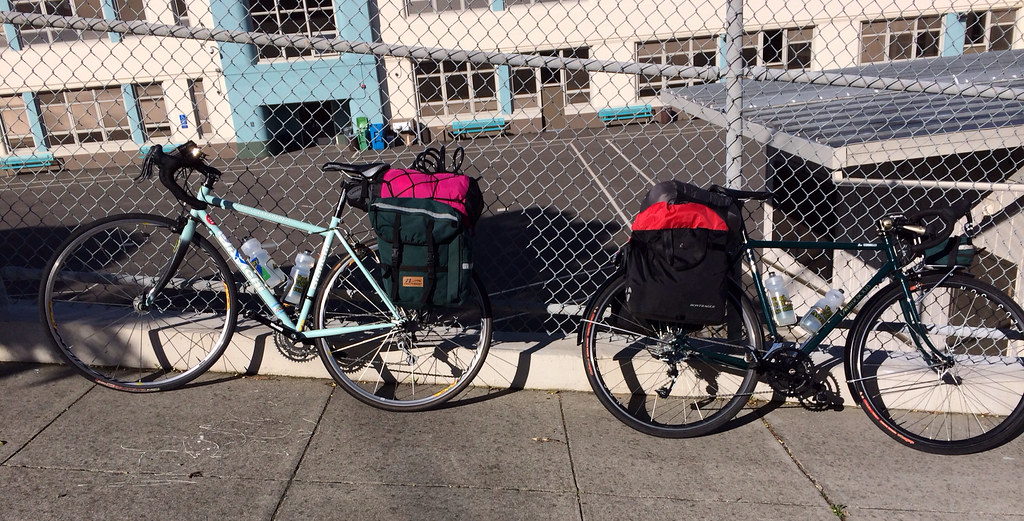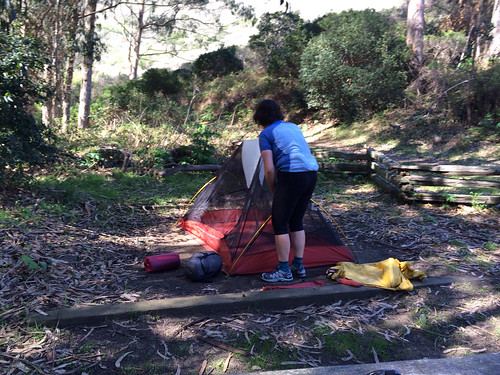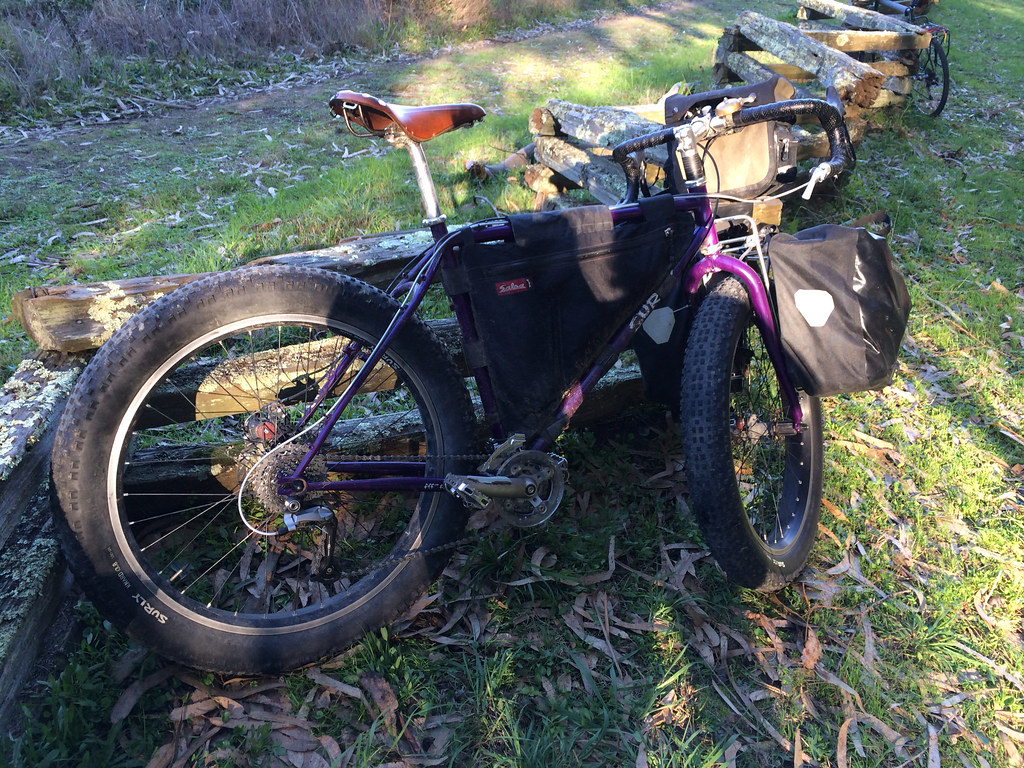Epic Bike Tour: the Marin Headlands
Cara wanted to do a bike tour, so when we were visiting Ely Rodriguez to talk about a handlebar bag, he suggested the Marin Headlands as an excellent destination. The Marin Headlands are just north of San Francisco, across the Golden Gate Bridge, but I immediately embraced the idea. It was a good chance to try out the whole bike touring process: pack stuff on bike, ride to destination, camp out, pack up and leave. The rides themselves would be short, less than 20 miles following the most direct route, but it would provide a good chance to learn what works and what doesn't. On a bike tour, the actual riding is just a part of it, maybe even a minority. This would test the rest.
First, I had to reserve the campground. This turned out to be surprisingly easy. Many campgrounds in the SF Bay area need to be booked months in advance, but in March, Haypress campground in the Headlands obviously isn't one of them. I initially tried to get Hawk, which is the most remote campground there, but it was full so Haypress was recommended instead. Haypress is down a 1 km fire road off Tennessee Valley trail, really Tennessee Valley Road at that point, just west of the stables. It's super-easy to reach on bike, with the only unpaved portion the 1 km fire road, and very little climbing. Hawk, on the other hand, would have been up an extended dirt climb, plus a 1 km access trail which was a total unknown to me. So we took Haypress.
The next step was the bike. Part of the reason I got the Winter Allaban was for bike touring. It has a randonneuring rack in front, an "optional" rear rack for panniers. I had bags for neither. Ely is making me a rando bag, but that's not ready yet due to a delay getting the fabric. And I emailed Chris @ Roaring Mouse Cycles to ask him to order some Arkel Dry-Lite panniers, but those hadn't arrived. So I sent out a note asking for a loaner, and a Roaring Mouse teammate offered to let me use his Bontragers, idle after an extended tour in France. Those worked out perfectly for the rear rack.
For pedals, I still had the Garmin Vector Look-compatible Exustars. These go much better than Speedplays when walking in dirt is involved. Unfortunately I'd removed and reinserted the batteries, since I'd re-torqued the pedals, and the left battery cover had gone in crooked, not closing all the way. As a result I didn't have power data until I realized the cause of the problem at the end of the trip. Ideally I'd have used my BeBop pedals, but I still need to mount the cleats, a non-trivial job of shoe surgery.
I was faced with the situation that my low-trail (3.9 cm) rando bike was going to be essentially 100% rear loaded. Jan Heine, who just published a report of a bike-camping trip he did with similar geometry where he was 100% front-loaded with low-hanging front rack but no rear rack (photo), would not approve, not at all.

My bike on right, Cara's on left. My front rack is supporting only my tool bag, which didn't fit on the rear. I packed it smarter for the return.
The packing list: my REI 10F down sleeping bag, a light weight pad, Cara's MSR Hubba Hubba tent, most of our food supply, a T-shirt, a sweatshirt, running shorts, running shoes, my Lake Chabot running shirt, a lightweight cycling windbreaker, a and a pair of underwear. I had my phone in my jersey pocket, and I had a large belt-pouch for storing food we bought along the way. This obviously isn't excessive, but neither is it minimalist. The tent had spikes and a ground pad we could have left home, or potentially even the tent could have been omitted completely. The sleeping bags could be replaced with quilts. But I don't have a quilt, and I like having a tent, so it's what we had. Actually, I regretted not bringing any reading material along, although Cara came through with an Outside magazine which I could read.
I was slightly nervous about starting, as from the first clip-in we were to descend two blocks peaking out at close to 20% grade. But the bike handled it well, and the brakes had no issues even with the heavy load.
From the bottom of the hill we road out to the Embarcadero, along the waterfront, past Fort Mason, then along Marina Green to the Golden Gate Bridge, At the first traffic light I learned the bike didn't handle quite like it does unladen. When I went to clip in I slightly lost balance. But once I came to terms with the substantially increased inertia, I was fine. It was a bit like starting a tandem.
But the handling was always slightly squirrely. There was a bit of a feeling of pulling a trailer. I'd steer, and the bike would delay in turning the corner. This is why Jan Heine advocates carrying weight in the front of the bike. I'll need to see what I can do next time. Maybe just the addition of a handlebar bag will help.
I was fine on the cobblestones near Pier 39, and had no issues on the climb of Fort Mason or on the following descent. Then came the bridge, with its cross-winds. Going around the supports, with heavy tourist-bike traffic, I unclipped going in, but then pedaled the rest of the way. I didn't trust the handling enough to go into the blind corners ready to dodge a misplaced tourist.
When we reached Tennessee Valley road, we stopped for fruit at the outstanding outdoor market at the intersection, open only on weekends. I love the dried parsimmons there, but the fresh fruit, preserves, and fig bars are all worth stopping for.
At the end of the Tennessee Valley Road rollers, we passed the jam-packed parking area (pun not intended) at the trailhead, then through the barrier. It's only a few hundred meters from there to the entrance to the camp access road. But Cara wanted to ride to the beach, so we kept going.
On a short roller, I went to downshift in the rear, but was in my big ring (48) front and that led to a 48-32 cross-chain. I threw my chain onto the small ring, which caused the bike to stall, and I hopped off. I walked the rest of the way up the short hill, went to get back on, but the loaded bike didn't react as I expected, and my foot slammed into the top tube. Oh, no... a scratch. The first. I felt terrible. I resolved to adjust the front cable tension as soon as we got into camp. It needs to be fine tuned with the wide-range gearing on this bike: 32-48 front, 12-32 rear.
The ride to the beach was fun, with a steep dirt descent which I knew would be even funner coming the opposite way. We at lunch at the beach, then turned for the return.
At that descent-now-climb, I made use of the low gearing on the bike, and headed up. Cara initially followed but decided, wisely, it was smarter to walk. There were some ruts which caused me to dodge left, then I dodged left again, then there was no more left. But losing momentum, I cut back to the right across the ruts, and made it up the hill, despite the load. I wondered how that would have gone with a front-loaded bike.
Back to the camp road, we turned left to go to camp. The road had recently been muddy but the lack of rain for the past few days had dried it out. It was rough in spots, with horseshoe hoof prints, and plenty of horse droppings. The trail led only to the camp-site, so I found the heavy horse traffic surprising.
At the camp site we took the furthest of five spots, thinking this would provide the least noise, but a large group moved into the adjacent spot. They weren't too loud, though.

Setting up camp
With camp set up, I was able to adjust the derailleur. One issue was the ramp adjust was too slack. It's best to have the pulley track relatively closely to the cogs, and the gap was too large. That generally makes everything work smoother I'm not sure if this contributed to the front derailleur issue. I also adjusted the front cable tension slightly. It was only problematic in the big-big cross-chain combo. Hopefully the tweaks solve the problem.
With camp set up, I got ready for my trail run. I was unsure how my legs would respond as I set off back down the camp access trail, but they were fine. I did a bit over 10 km up Fox Trail, down Coastal, out to the beach and up the stairs to the overlook, then back on the Tennessee Valley trail.
Potable water is hard to find in the Headlands, and neither of the two sources I know, the visitor center and Rodeo Beach, were anywhere close. So with my run finished, our bikes unloaded, I remounted a pannier and we rode back up Tennessee Valley Road into Sausalito with Cara's expandable water container in search of a supply, and also coffee for her Thermos for the morning. It was really nice being back on an unencumbered bike. We found water at the San Francisco Running Company, a fantastic trail-running-focused store. I resisted the temptation to immediately buy not just one but multiple pairs of trail shoes, for different conditions and run distances. My New Balance 970's seem to work fine, although on gravelly trails the traction could be better. I chatted with the co-owner awhile: he finished 17th in the Western States 100 in 2011, and is training for the 2014 race. While I was there, Cara got coffee at a nearby Starbucks. It was actually still warm the next morning.

Surly Pugsley in the nextdoor tent site
On the way back to camp, we stopped at the Tennessee Valley parking area, near the stables, where Inside Trail Running had the final rest stop for their Marin Ultra. A 50-miler runner (the long distance for the day) was recovering for the final 9 kms to the finish, which was near Fort Baker. After he was gone I chatted a bit with the volunteer, expressing my trepidation over the upcoming Woodside Ramble, on April 13, which would be my first ultra at 50 km. He said the trails in Huddart and Wunderlich, due to relatively recent resurfacing, were in excellent shape for running a first ultra (the resurfacing was a bit controversial, motivated by the local equestrian community). His advice: start conservatively. Obvious advice, really, but it's important to hear it over and over, from experienced 50 km'ers like him. It needs to be a mantra I drill into my brain during the beginning of the race. It can be incredibly tempting to follow the 30 k'ers, to run at a pace I know I can run.... for 30 km. Save the speed for the rollers, he said, at the top of the first climb. I'm not in the race "just to finish", but finishing well requires finishing, and if I lose a place or two for too conservative a start, that's way, way better than losing 10 or more spots for starting too fast.
I'm not a campfire guy or an artificial light guy when camping. When it's dark, I go to sleep. When it gets light I get up. This seems the most natural approach, and the most restful. I was awakened by the howling of coyotes during the night. Not much land for coyotes, sadly, but fortunately what land was spared was only just: the Marincello housing development, for example, had been a done deal before protests stopped it.
The next morning, legs still tired from the previous day's run, I put on my running clothes and headed out of camp again. This time I went the opposite way from the end of the camp access road: out to the Tennessee Valley trailhead, past the stables, up Bobcat, out and back to the Hawk campground, Alta, SCA, down Coastal, up Miwok, down Old Springs, past the stables again, and back to camp. It was just over 20 km. That made a solid two days of running, although my legs were tired.
Despite the tired legs, it was time to return home. So we packed our stuff and back we went. The cats were hungry, Cara said.

Comments